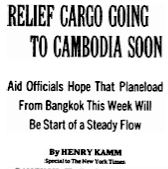Public Health and Humanitarian Action
The politics of humanitarian relief in Cambodia
... Efforts to launch a large-scale humanitarian aid operation in Cambodia were slow and fraught with political difficulties. The United Nations Children’s Fund (UNICEF) and the International Committee of the Red Cross (ICRC), known together as the Joint Mission, negotiated with Vietnam and the new Cambodian government to begin a relief operation. The new government was led by Heng Samrin, a former Khmer Rouge leader who had defected to Vietnam. The Vietnamese maintained a significant level of influence and control over the new government in Phnom Penh, as a result, negotiations to initiate a relief operation had to be conducted in both Hanoi and Phnom Penh. These efforts were continuously jeopardized by geopolitical tensions.
The Cold War had a substantial impact on the Cambodian crisis. With the recent warming of relations between the United States and China and the conflict between China and Russia, shifting Cold War dynamics had a significant impact on the Cambodian crisis. In this case there were essentially two sides: on one side was the Soviet Union, Vietnam, the Soviet Bloc countries and the new Cambodian government led by H[e]ng Samrin; on the other side were China, United States, Thailand, Singapore and most other western countries. The H[e]ng Samrin government in Phnom Penh was not diplomatically recognized by any western government. Only the Soviet Union and Soviet Bloc countries supported the Vietnam and its occupation. China, the only major government that recognized and supported the Khmer Rouge while they were in power, lobbied fiercely on their behalf at the international level after the Vietnamese invasion. In fact, after Vietnam occupied Cambodia, China briefly invaded North Vietnam to “teach them a lesson” and attempt to draw the Vietnamese army out of Cambodia. To deny the new Cambodian government recognition and the Vietnamese legitimacy China, Thailand [all of ASEAN led by Singapore], the United States, and most other western countries voted in 1979 to continue to recognize the Khmer Rouge as the legitimate government of Cambodia, though they controlled very little of the country.
Regional tension between Vietnam and Thailand, countries that were wary of each other’s regional intentions, further complicated the Cambodian crisis. Cambodia had traditionally acted as a buffer between Thailand and Vietnam. For hundreds of years the Vietnamese and Thais vied for influence and control in Cambodia. With the recent expulsion of the United States from Indochina and the Vietnamese invasion of Cambodia Thailand feared Vietnam’s expansionist intentions. With the Cambodian buffer removed, the threat of a direct conflict between Vietnam and Thailand loomed large.
Amidst these tensions, the Joint Mission’s attempted to create a humanitarian space to operate a relief program. Throughout 1979, the Joint Mission negotiated for greater operational presence in Cambodia, something that Vietnam and the new Cambodian government resisted. On August 9, 1979 UNICEF and ICRC delivered their first shipment of relief supplies by plane to Phnom Penh. From August onwards a slow but steady amount of relief aid began to enter the country by plane and boat. The logistical and operational capacity of the Cambodian authorities to manage the relief aid was a source of constant debate.
Another famine?
... At the end of March 1980, international relief agencies predicted the failure of rice harvest and massive food shortages in the coming year. At a conference with donor countries, the Joint Mission requested new pledges for funding to deliver rice seed to Cambodian farmers to plant now for the next harvest in December. The problems of delivery and distribution of food aid inside Cambodia were omnipresent. Whether the new Vietnamese-backed government in Phnom Penh was able to distribute food throughout the country to those most in need was a debated subject for most of 1980.
There appeared to be no end to the refugee crisis at the border or the threat of famine inside Cambodia. In March 1980 William Shawcross published a 6-part series in The Washington Post on the relief effort in Cambodia and at the border. Henry Kamm visited Cambodia in April and wrote a series of articles highlighting the obstacles of food delivery and distribution and supporting his belief that food was not being properly distributed. ...
Offers of Help
Meanwhile, back in the US and Europe, considerable attention was being directed towards the Cambodian crisis. On Dec 26-29, 1979, the musician Paul McCartney and Kurt Waldheim, the Secretary-General of the United Nations, organized a four-night benefit, Concerts for the People of Kampuchea, to raise funds for UNICEF and UNHCR. The concert featured Paul McCartney and Wings, The Who, Queen, Elvis Costello, The Pretenders, The Clash and other artists at the Hammersmith Odeon in London, England. ...
March for Survival
Meanwhile, the refugee crisis at the border became a cause célèbre among many activists, artists and academics from the West, many of whom visited the border camps. In early February, for example, a group of aid workers, peace activists and celebrities, including Joan Baez and Elie Wiesel, led a “March for Survival” at the border town of Aranyaprathet, demanding an end to what they perceived was the deliberate obstruction of food distribution by the Vietnamese. Using a bullhorn the group offered 20 truckloads of food and medicine to the Vietnamese and Cambodian soldiers on the other side of the border. Though they received no response the group donated relief aid and money to relief agencies on the border. IRC used some of that money to print school textbooks.



No comments:
Post a Comment